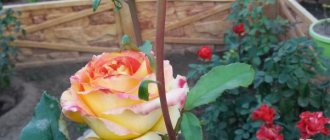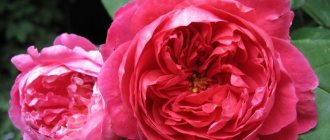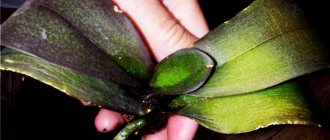Roses are still the most popular on the flower market. They have been popular for decades due to their abundant flowering, the wonderful aroma of the blooming buds and the beautiful appearance of the shrub.
Among all the groups of roses, another one has recently been identified - spray roses (a separate variety based on the floribunda class). A similar division occurred around the middle of the last century. Although the bushes belonging to the “spray” variety had different heights, what they had in common was abundant simultaneous flowering - small roses (about 6.5 cm in diameter) bloom in large numbers on the shoots. There can be up to 12-16 buds on one stem.
One of the most beautiful varietal spray roses is the Fire Flash rose. Next we will talk about how this variety was bred and the main characteristics of the bush rose Fire Flash. Special attention will be paid to the advantages and disadvantages of the variety.
Rose Fire Flash
Embodiment in bouquets
The history of the appearance of the bush rose began in China.
There, for the first time, they began to collect bouquets of these flowers and decorate homes and temples with them. In Greece, the rose was considered a sacred flower because the shape of its bud resembled a circle - a symbol of infinity. Subsequently, thanks to crossing, the number of types of roses became so large that flowers began to be divided into varieties. The bush rose can be considered the ancestor of modern hybrid roses, although it was originally a wild plant. It is interesting that the first attempts to grow roses in Russia date back to the middle of the 16th century, but flowers became widespread only in the 18th century, almost simultaneously with the growth of their popularity in Western Europe. The rulers of the empire greatly contributed to this: for example, Catherine II ordered the creation of the first rose garden in Russia in Tsarskoye Selo Park, it was called the pink field.
Thanks to the work of breeders, modern bush roses can be grown not only in gardens, but also at home. These plants are very popular among florists; the delicate small buds are well suited for creating bouquets and compositions, and cut flowers will last in a vase for at least a week.
Roses are heat-loving plants, but modern varieties are adapted to the climate of central Russia, thanks to which they tolerate both summer heat and winter frosts well.
It is important to remember that in the summer you can maintain a rose in the heat by providing it with timely watering and spraying the foliage so that it does not dry out. And in the fall, when the air temperature drops below -5 ° C, it is necessary to cover the bush
For shelter, you can use sand, spruce branches or special synthetic material. With such simple care, temperature changes will not be harmful to the plant.
The main rule of watering roses is to do it as needed. Immediately after watering, the soil should be moistened to a depth of about 25 cm and the procedure should not be repeated until it dries. Excess water in the root system can harm the plant, the roots will begin to rot and the flower will not be able to grow and produce buds. The most favorable time for watering is early morning or evening. In this case, the moisture will have time to reach the root system and will not evaporate too quickly. On average, one adult rose bush requires about 9 liters of water, and the next watering is carried out no earlier than a few days later.
Shrub roses love a lot of light. If you choose a sunny plot of land for them on the south side, they will certainly delight you with lush flowering all season long. But even if such a site is not found, they feel great in partial shade. Too dark corners of the garden are not suitable for such flowers and the plant may die.
Shrub roses are not very picky about soil and, with proper feeding, can thrive almost anywhere. Fertilizing the soil for roses can be divided into three stages: the first time the plant is fertilized in the spring at the beginning of the growing season, the second when the plant begins to form buds, and the third at the end of flowering. There are ready-made mixtures for feeding plants, which greatly simplifies the gardener’s work. But you can prepare the mixture yourself by purchasing all the elements separately at a gardening store. The main thing is not to forget to maintain the strength of the bush, and then it will delight and decorate the garden for many years.
Shrub roses bloom throughout the summer and decorate the garden with lush greenery and flowers of various shades. A distinctive feature of roses of the rose hip family is their ability to grow quickly, so when choosing a place for planting, you must take into account that the plant will grow several times.
To form a beautiful composition, it will be necessary to install supports and trim roses and faded buds.
You should also remove thick shoots at the base of the bush in time, otherwise they will take away the main strength and prevent new buds from forming. But it is better to leave the young branches, it is on them that fresh flowers will grow, and the longer they are, the more inflorescences there will be.
https://youtube.com/watch?v=GG0y_UsW7U4
Required care
Caring for shrub roses cannot be called too difficult: any gardener can handle it.
However, these plants are quite capricious to require compliance with a whole set of rules on which their beauty and health depend. Planting plants . Shrub roses are sun-loving and do not grow well in the shade. A bright, wind-free place is suitable for planting. The soil should be rich in humus and freely allow air to pass through. Flowers feel best in slightly acidic, heavy soil that does not hide groundwater.
Before planting, you need to shorten the roots of the roses, remove all dried parts and cut the stems at a height of 15 cm. After this, the roots are lowered into water for several hours, where they will wait for planting.
The diameter of the hole should be at least 40 cm, and the depth is determined using an earthen ball with roots: about 10 cm is counted down from it. Be sure to loosen the bottom with a pitchfork. Another way to determine the required depth of the hole is to find the grafting site, which should be covered with 3-4 cm of soil.
The soil remaining after digging the hole should be mixed with compost in a ratio of 3:1. In addition, you need to add a handful of wood ash to the soil. Immediately after this, the pit is filled with a bucket of water with a pre-dissolved heteroauxin tablet.
The distance between bush rose seedlings is purely individual. Depending on the variety, it can be 1-2 m. The same distance is maintained between the rows.
The best time for successful rooting of bush roses is from early September to mid-October. It is recommended to buy seedlings immediately before planting, and not in the spring months, because in the spring those specimens that were not purchased in the fall are usually sold. It is important to select healthy, viable seedlings to ensure they will survive the winter.
Watering flowers
Shrub roses are not among the plants that need very frequent watering.
In their case, it is better to focus on the condition of the soil: if it is dry, then it is time to water the bushes. Roses like infrequent but abundant irrigation. This watering regime is not suitable, however, for first-year bushes: their soil needs to be moistened every two days. In spring, young shoots and leaves enter a phase of active growth, which means they require increased watering . In hot summers or during periods of drought, bushes are irrigated more often than usual. The standard volume of water poured under an adult bush is 10 liters. It is very important that strong pressure does not wash away the soil from the roots, so the drip method of irrigation is preferable. In addition, you need to control the temperature: cold water can significantly damage the root system.
At the end of the flowering season, that is, towards the end of summer, the volume of water should be reduced to avoid stagnation of excess moisture, which can cause fungus and rotting of the roots. This does not mean that you should completely stop watering. Water supplies are very important in winter.
Feeding with fertilizers
Shrub roses require strict adherence to the feeding regime. On soil poor in nutrients, they will quickly wither and be defenseless against numerous diseases.
The monthly artisan rose “menu” looks like this::
- In April, preventative pruning of roses is usually carried out, immediately after which the bushes must be fertilized with nitrogen contained in ammophosphate, ammonium nitrate and urea. In addition to nitrogen-based fertilizing, roses absorb organic matter well, including compost teas, which promote plant growth and proper development of the root system.
- The May list of fertilizers includes saltpeter, spring kemira, organic matter and urea. However, if for some reason the roses received a dose of fertilizer in April, they do not need this feeding.
- In June, the rose bush begins to lay buds, so the plants need fertilizer twice a day. For these purposes, solutions of mullein, horse manure, ash and chicken droppings are best suited. They need to be sprayed in the evening, getting only on the leaves of the inflorescences. Do not forget about foliar feeding, carried out using potassium fertilizers such as potassium magnesium and nitrate.
- In August, the bush rose receives its last serious feeding. Potassium and phosphorus, bromine, iron, zinc and molybdenum are introduced into the soil independently of each other. This is necessary for successful wintering of rose bushes.
- In September, the flower is not fertilized with anything other than potassium and phosphorus superphosphate. Nitrogen should be completely eliminated because of its stimulating effect, which will prevent roses from going dormant.
Timely pruning
One of the most important aspects of caring for a bush rose is its timely pruning. This will not only help the young shoots develop properly, but will also preserve the decorative appearance of the plant.
Pruning should be regular:
- In the first year of planting the bush, it is necessary to get rid of all the buds that appear. Their size should not exceed the size of a grain. The same applies to wildly growing shoots. In the second year you need to allow the buds to open.
- In the second year after planting the bush, spring pruning begins. This is done in order to get rid of dry and non-viable shoots. In addition, crossing branches with dark bark are pruned.
- Powerful branches inside the bush also need systematic pruning.
- Frozen buds must be removed immediately.
- In summer you need to thin out the branches and cut off dried flowers and shoots.
- To avoid the development of all kinds of diseases, you need to regularly inspect the bush for blind shoots and cut them out immediately.
- In order for the bush to maintain a neat shape, it is advisable to trim branches that violate the crown line.
Site selection and soil preparation
Both beginners and experienced gardeners can grow crops; the main thing is to follow all the nuances of cultivation. To plant a plant in the garden, you need to choose a sunny but protected from the winds area.
It can take up to three months to prepare high-quality soil for flowers, so for planting in the fall, the soil must be prepared in the summer or in October, if planting the crop is planned for spring.
The basic rules for soil preparation are as follows:
- We remove weeds and their rhizomes from the site.
- We dig up the soil onto the bayonet of a shovel while simultaneously transferring the soil. Next, make a ditch 40-50 centimeters deep and fill the bottom with top soil with fertilizers, and then the bottom layer mixed with fertilizers. Over several months of standing, the soil in the ditch sags and becomes saturated with useful substances. Along with this, excess moisture also leaves.
- Some gardeners immediately plant plants in pre-dug soil with dug holes, but this method is considered less effective.
Many gardeners do things differently. They dig up the area using a spade blade without prior leveling in the fall. This will help freeze the top layer of soil and destroy pathogenic bacteria and microorganisms harmful to roses and pest larvae. Fertilizers added during this period can dissolve over the winter.
With the arrival of spring, the planting site is leveled with a metal rake and holes for planting crops begin to be dug. The depth and width of such recesses should be 25-30 centimeters higher and wider than the root system of the plant. If these parameters are observed, the pit is filled with light nutritious soil, which will give impetus to the intensive development of the root system.
When preparing the soil for a rose garden, it is necessary to take into account the influence of its predecessors. It is known that roses do not grow well in areas where there were previously cinquefoil, cherry, quince or hawthorn. In such areas, a 50-centimeter layer of soil is removed and replaced with new soil.
Flower propagation
The variety of border roses can be propagated in several ways.
Seeds
The most labor-intensive, complex and unjustified method of propagation is seed. Seeds take a long time to germinate and not every gardener dares to do this. Therefore, this method is mainly used by breeders.
By layering
This is a method of digging in a shoot from an adult bush. Within a few months the cuttings will give roots and be fully viable. After rooting, it is separated from the mother bush. The method of propagation by layering has proven itself well among gardeners.
Offshoots of the roots
A young shoot with roots is separated from the bush and planted in a separate place.
By cuttings
The most common and easiest method of reproduction. Cuttings are taken from the middle of a strong shoot. With the help of a root growth stimulator, the root system is expanded in water and planted in a greenhouse. There the plant gains strength before planting in open ground.
Propagation by cuttings is the most common method of propagating roses.
By division
An adult bush is dug up and divided into several independent plants. The main condition for division is that each separated sprout has enough roots and several healthy buds for growth.
Good to know! The division method is considered the fastest method of reproduction. At the same time, the crop does not lose the characteristics of the variety.
Description of a group of spray roses
Many consider them to be a subgroup of floribundas. But it's not right. Spray roses are an independent, fairly large group of roses that have their own distinctive features:
- long and abundant flowering,
- unpretentiousness to living conditions and endurance,
- adapted for cultivation in central Russia,
- frost resistant
- few or no thorns on the stems,
- long continuous flowering with timely pruning,
- beautiful in landscape design and in bouquets,
- suitable for growing in containers for landscaping balconies and terraces,
- The flowers of some varieties have a light, pleasant aroma.
The group got its name from the English spray, which means “spray”. People also call them “wedding” because they are used to create boutonnieres and bouquets for brides. A miniature or medium-sized scattering of buds can be concentrated on 1 branch, which not only looks original, but is also convenient for creating floral compositions. Read: “The best varieties of roses by color.”
Shrub roses: planting and care
- Planting roses
- Selection of seedlings
- When to plant roses?
- Selection of location and soil
- Landing technology
- Care of young roses
- Top dressing
- Watering
- Trimming
- Preparing for winter
Shrub roses are very attractive and are the most popular among gardeners. They are most often used for decorative purposes in landscape design, to decorate flower beds, gardens and park areas. Rose flowers come in different colors depending on the characteristics of the variety and always have a pleasant aroma, which is clearly felt during the flowering period. Shrub roses belong to the Rosehip genus. This is a spreading bush that reaches 2 m in height. The leaves are oval shaped with serrated edges. The peduncle is most often long, its dimensions vary from 15 to 85 cm. Inflorescences can grow singly or in groups, which also depends on the variety. Today we will tell you how to grow bush roses yourself and what care they need.
How to choose the right seedlings
Rose planting material can be sold in mini containers or in bags filled with nutrient substrate, less often in open form. When planting in the fall, it is better to choose seedlings with an open root system, but for planting in the spring, plants in containers are better suited.
Before purchasing, carefully inspect the bush and its root system for damage and other defects, such as mold and dried areas.
If you purchase plants in a bag, pay special attention to the condition of the soil; it should be crumbly and not have a specific odor. The best choice would be a strong, healthy seedling with white roots at the bottom.
Description
Flashfire Fist is Endeavor's signature technique. Endeavor raises his fire's temperature to its highest level and maximizes his power. Doing so, the Flame Hero can unleash devastating flame attacks or increase his speed dramatically. Flashfire Fist condenses Endeavor's flames into a white-hot point and is meant to act as a one-hit finisher. Endeavor can perform several variations of his Flashfire Fist move, each with a different form of attack.
Endeavor used Flashfire Fist several times against the High-End Hood, which raised his temperature dramatically, a glaring weakness when using this technique.
During the war on the Paranormal Liberation Front, Shoto is revealed to have adopted his father's technique, using it to perform his Super Move: Flashfire Fist — Jet Kindling. Dabi later revealed he's learned the technique as well.
Description of the variety
Fire flash has compact dimensions: about half a meter wide and 50 to 70 cm high. The plant’s strong shoots are covered with small, dense, dark green, shiny leaves. The flowers that appear on the bush are small: 5-6 cm in girth. They are formed in racemose inflorescences of 5-10 pieces. The buds of this culture are characterized by a classic shape.
The most attractive thing about the inflorescences of this rose variety is their bright, two-tone color, combining sunny yellow and rich crimson shades. Thanks to such an unusual coloring, as well as the contrast of variegated buds and green foliage, the perennial looks very elegant, spectacular, and cheerful. The first flowers appear on the plant in May. The variegated rose continues to bloom until late autumn. In most cases, flowers do not show the center even in the full bloom phase. Only a few of them show their stamens, maintaining their original shape. They smell nice, although the aroma they emit is rather weak.
The buds bloom on the bush quite slowly, which allows you to fully enjoy the wonderful spectacle. The flowering of the decorative perennial Fire flash can be safely called lush. It passes in three abundant waves, in the intervals between which the number of inflorescences on the bush is quite moderate.
The features of this rose include:
- high resistance to diseases and low air temperatures;
- unpretentiousness;
- maintaining the integrity and appearance of flowers under the influence of rain;
- almost complete absence of sharp thorns on the stems of the plant.
Fireflash flower petals do not bake and do not fade in the sun, although with age their color does fade, which, however, does not negatively affect the decorative appearance of the shrub.
Floribunda rose Gräfin Elke zu Rantzau
A bushy but upright floribunda with a strong aroma. Buds with double flowers and small clusters. Disease resistance is particularly strong against black spot, making it a good addition to the Parfuma® collection. Named after Countess Elke of Ranzau, who died in 2015 at Breitenburg Castle, founder of the Breitenburg Golf Club.
- petal color creamy white
- plants per m² 4 - 5
- re-blooming period
- growth straight, vertical
- natural width: 50 cm
- bud diameter: 8 cm, 9 cm, 10 cm
- natural height: 80 cm
- plant: erect,
- year of introduction: 2019
- breeder: W. Kordes 'Söhne
- collection: Parfuma
History of the variety's creation
The spray rose variety was bred by breeders from Interplant (Holland). The name of the variety “Fire Fresh” translated from English means “fiery flash”.
Growing roses
Growing and caring for this ornamental shrub is no different from growing other varieties of roses. But this variety is particularly resistant to diseases, so preventive treatments are not necessary.
Landing Fire Flash:
- To grow a two-color rose, you need to select loose and fertile soil (with a slightly acidic reaction).
- Dig a hole (45 cm width and depth).
- Fill the bottom of the loonie with drainage.
- Add humus to the hole and add some soil mixture.
- Place the seedling in the hole.
- Spread the roots of the seedling and begin pouring the remaining soil mixture.
- Compact the soil and water the plant at the root.
Growing a flower: how to plant it correctly in open ground
When planting a flower in open ground, it is important to follow all the rules and recommendations. The place and time of planting, as well as suitable soil, are of great importance.
In what form is planting carried out?
Rose Weasley is most often grown using seedlings. 2-year-old bushes can be purchased at special garden centers; this will allow you to get a flowering plant much faster.
What time does boarding take place?
The seedlings are planted in the spring (mid- to late-April), when the frosts have ended and the soil has warmed up well.
Note! In autumn, the bush can also be planted, but the chances of rooting are much less
Selecting a location
The English Weasley rose does not like direct sunlight, but a heavily shaded area can affect the color and growth of the bush. In addition, there should be no drafts on the site; they will also have a negative impact.
Important! Since this variety does not like excess moisture, it is important that groundwater does not pass close to the site. The easiest way to avoid this is to choose a place on a slight hill
How to prepare the soil and flower for planting
To prevent water from stagnating, the soil must be loose and breathable. To do this, you need to increase its drainage, for example, add sand to the soil. It is also worth feeding the soil with the necessary fertilizers.
You can stimulate the growth of a seedling by placing its roots in a special saline solution for a while before planting.
Under good conditions, Weasley will delight his owner with his lush color for a long time.
Step by step landing procedure
Planting is carried out according to the following steps:
- Digging a hole 40x40 cm (depending on the size of the roots, the hole can be increased).
- Preparation of the substrate from a mixture of sand, peat, humus and soil fed with fertilizers.
- Laying this composition on the bottom of the hole in a small layer.
- Place the seedling in the hole and straighten its roots.
- Sprinkle the hole with substrate.
- Abundant watering.
- Hilling up bushes.
Caring for Fire Flash
Water the bicolor rose regularly and moderately throughout the growing season; as for the hot, dry period, watering should be plentiful at this time. Water Fire Flush a couple of times a week, in the morning or evening.
To encourage Fire Flash growth and lush foliage, apply a nitrogen fertilizer in the spring. Also in spring, this variety needs pruning; cut off diseased and weak shoots.
During the budding period, the plant needs mineral complexes. As soon as the flowering period is over, the two-color rose needs to be fertilized with phosphorus-potassium concentrate.
The plant is famous for its high resistance to frost, but despite this, it should be covered for the winter.
Characteristics of popular Fairy rose varieties
Quite a lot of time has passed since breeders bred the first ground cover roses. Today, there are countless representatives of this plant, which can be classified according to the color of the buds, beauty and flowering indicators. If we consider the most popular varieties, these include:
Fairy Dance Rose, which is distinguished by flowers of a dark pink hue, which have a rounded shape. Inflorescences tend to fade gradually, but they do not become less attractive. During periods of heavy rain, Fairy Dance rose flowers may become spotted, and a barely noticeable golden stamen appears in the middle of the inflorescence.
Rose Fairy Dance
- Ground cover rose Red Fairy - the main decoration of the variety is its beautiful bright red miniature buds. Against the background of dark green foliage, the Red Fairy rose and its flowers look very beautiful.
- Rosa polyanthus Ze Fairy. The color palette of inflorescences of this variety is represented by all shades of orange and pink. The plant has not very large but strong buds that are resistant to rain and also have excellent immunity to disease.
- Rose White Fairy, which most gardeners consider the best representative of the ground cover variety. This plant took part in numerous exhibitions and was awarded honorary awards. The White Fairy bush is decorated with small semi-double buds that have a pleasant and light aroma.
- Rose Lovely Fairy, the advantages of which are represented by dense terry, dark red hue, moderate aroma, and medium-sized flowers.
- Rose Yellow Fairy - this variety is relatively young due to the fact that it was created in 2006. But in such a short time, the plant has already become a hardy “fighter”, suitable for almost any growing conditions. The Yellow rose bush is decorated with lush, soft yellow inflorescences with a pleasant aroma.
- Rose Pink Fairy, which has charming cup-shaped buds with a red-raspberry color. Due to the rapid growth of the bushes, this variety is very popular; its height, in some cases, can reach 4 m. Another advantage of the rose is its high frost resistance.
Rose Pink Fairy
Rose Poetry
Note! Each variety of ground cover rose has its own advantages and disadvantages. When purchasing this or that planting material, you need to proceed not only from personal preferences, but also from the main characteristics of the subspecies
Fire Fresh in landscape design
Many florists like to use this ornamental shrub not only for making bouquets, but also in landscape design. Fire Flash roses are often used to decorate borders. They are bright and miniature, thanks to this they can be used in landscape design without any problems, they will fit into any convenient place.
It will look especially impressive in the design of a garden or flower garden, in group and mixed compositions. Very often this ornamental shrub is planted in various flower beds.
Use Cases
The Fire Flash variety will fit well into the design of a garden or flower garden. It is used in group and mixed compositions, for decorating mixborders, planting in ridges and round flower beds. This spray rose is often used to decorate garden paths. It looks impressive against the backdrop of a green grassy lawn, in company with irises, lilies, fragrant herbs, ornamental grasses, and low-growing coniferous plants. Fire flash can be planted along the fence, near the facade of the home and at the front entrance to the house, near the gazebo, garden bench, or sculptural composition. As an accent plant, it should be placed in the foreground of the flower garden. A rose bush is also appropriate in a rose garden.
The beautiful Dutch plant is suitable for growing in containers that are placed on the veranda, balcony, and terrace. It is also cultivated as a cut variety, since the flowers of this rose do not fall off for a long time and can give a festive look to any bouquet.
Rose Fire Flash is a very compact small shrub of Dutch origin. The variety belongs to a group called spray, which appeared among breeders quite recently.
If we give this flower a brief description, we can say that it looks like a hybrid tea rose in miniature, since when the buds open, they exactly repeat the shape of the flower of a taller and more branched “relative”. The original purpose of the variety is to create small bouquets, and growing, planting and caring for it does not cause much trouble.
Pests
Microscopic spiders have appeared on the plant, and the rose is gradually becoming covered with cobwebs, what should I do? Spider mite
Are small green insects destroying your rose? Effective methods of pest control. Green rose aphid
Caterpillars have appeared on the rose and are twisting the leaves of the plant, how to deal with the pest Rosen leaf roller
Flat bumps have appeared on the shoots of the rose or on the underside of the foliage, how to deal with the pest Rosen scale insect
They also like to use it to decorate garden paths. They look impressive against the background of a grassy lawn, in a composition with fragrant herbs, ornamental trees, and small coniferous plants.
This spray rose can be grown in containers and used to decorate a loggia or terrace.
Advantages and disadvantages of the variety
The main advantages of the Fire Flash variety:
- The variety is resistant to many diseases.
- "Lush" flowering.
- The petals do not fall off for a long time.
- Can be used for cutting.
- About 10 buds can bloom on one shoot.
- The buds have a beautiful two-color coloring.
- Easy to care for.
- Pleasant aroma.
- The variety is characterized by increased resistance to pests.
Minuses:
- Weak aroma.
- Does not bloom well in the shade.
An overview of the Fire Flash variety can be seen in the following video:
The best peony rose varieties for 2022
The classification is presented in many colors. They are united by color:
- white and yellow;
- red;
- pink.
Officially, peony roses are not a separate species. Despite this fact, the group is distinguished by certain characteristics. Thanks to this, flower growers classify them separately from others.
Pink hybrids
This color is considered the most common among peonies. Color saturation varies depending on the variety. The petals are soft pink, lilac and even with a slight peach tint. The flowers of peony roses have dense, rounded petals.
Miranda
The Miranda bush grows up to 1.5 m. Single flowers are found on the bush. Roses bloom twice a year. The petals located close to the outer edge are almost white. The inside is a rich pink color. The smell is almost invisible, but very pleasant.
Rosalind
The variety is characterized by single cream-colored flowers. They are large in diameter, as they are 14 cm. Rosalinda is a variety of rose very similar to a peony.
Culture with red flowers
After pink comes red. It is considered classic, so there are many varieties in this color. They decorate various rooms during celebrations, make bouquets and grow them in the garden to admire.
Shakespeare
The variety, which is similar to peony, emits a strong odor. Shakespeare roses are large, double, reaching a diameter of 9 cm. Collected in groups of 3-5, they form inflorescences. The color can be deep red and change to purple.
The shrub is no more than 2 m in height. It rarely suffers from infectious diseases, is resistant to pest attacks and can easily withstand worsening weather conditions. Peak flowering is observed at the beginning of summer. The reappearance of roses occurs in the fall, but there are significantly fewer of them.
Munstead Wood
The bush does not stand out for its large size. The maximum height is 1 m, width - 0.6 cm. The flower petals are velvety. Munstead Wood has one interesting feature. The color of roses changes as they develop. At the beginning of the flowering season it is light red. Over time, the petals darken and become almost black.
Varieties with yellow and white buds
Among the peony roses there are yellow varieties. Many different species have been developed, but not all are suitable for cultivation in the country. Breeders present varieties adapted to climatic conditions.
Roses with white petals are very popular among florists. Their color is not pure, so yellowish, pink and cream shades are noticeable. The white peony rose is a beautiful sight that every person should see.
Alabaster
The variety looks like a peony. The inflorescence contains up to 6 buds, which over time turn into double flowers. Roses have straight and long stems, making them perfect for creating bouquets. Mature shrubs are low - only 1 m.
Claire Astin
A person who once smelled the flowers of this variety will never forget it. The aroma is so strong that it can be felt from a great distance. Buds appear on the branches twice a year. The average diameter of cream flowers is 11 cm.
Tranquility
The bush will decorate any plot of land. The small number of thorns on the branches makes it popular among gardeners. Women especially like it because of its small size. When the buds appear, they have a yellowish tint. As the flowers open, the petals become almost white. At the end of the season they bloom again.
Graham Toman
The height of the bush varies between 1.2 m. In regions with a hot climate it grows up to 3 m. Despite the large diameter of the flowers, they grow in inflorescences of 3-6 pieces. The aroma is weak, but pleasant and noticeable. During the first flowering, an abundant appearance of buds is observed. At the end of summer it blooms again.
Golden Celebration
One of the representatives of peony roses is yellow in color and has large flowers. When all the petals open, the diameter is 16 cm. The variety continues to bloom throughout the summer.
What it is? Characteristic
Rose black baccarat
Small-flowered spray roses are somewhat different from ordinary garden flowers. Rose bushes are quite compact in size, about 50 cm, but they have many side shoots. On each branch of the bush, depending on the type of flower, from 5 to 15 buds of different shades and colors can grow and open.
The rose flowers themselves are small in diameter, ranging in size from 3 to 8 cm, and have a light aroma. After cutting, they stand in water for a long time without losing color and freshness, they open gradually, and are often used for wedding bouquets and compositions.
This rose variety was bred to be resistant to planting in different climatic conditions. If the rose is watered correctly, pruned and fertilized in time, then small but spectacular flowers will decorate the garden from the second half of spring to late autumn, shimmering in red, yellow and cream shades.
The best varieties
In order not to make a mistake with the appearance of the garden and to collect beautiful bouquets all summer, you need to choose the right plant varieties according to the description and photo. The flowers on them can be of different colors and diameters, with double petals or with petals separated from each other.
The best varieties of roses:
Lovely Lydia. One of the tallest spray rose bushes, reaching a height of 70 cm. The flowers are small, pink in color, and bloom for a long time. Due to their abundant flowering and color, Lovely Lydia flowers are decorative and therefore chosen for wedding bouquets;
Lovely Lydia
Rose Fire King is one of the most beautiful varieties. Bright red, densely double buds, of which there can be up to 15 pieces on one branch, will decorate any bouquet and garden compositions;
Rose Fire King
The “fiery” variety of roses is Fire Flash, bright orange buds of large diameter that can stand in a vase for a long time. Flash's petals shimmer from yellow to orange, and roses of this variety can grow even in cold regions;
Fire Flash
A popular variety of flowers is Barbados. It is large in size compared to other varieties, and orange and yellow Barbados roses are often used in wedding bouquets;
Barbados
If you are looking for a compact small-flowered plant that will stand in water for a long time after cutting, opening and fragrant, then you should choose the Grace variety. Roses of the Grace variety have a delicate cream color and buds that do not open completely;
Grace
A spectacular, bright and disease-resistant flower is the compact Lancome. In this variety, the diameter of a loose bud can reach 7 cm, although the Lancome bushes themselves do not grow above half a meter in height;
Lancome
A popular variety of red roses is Mirabelle. The open red petals have a rich aroma, and shades of red can be both bright and light. Mirabelle grows up to 50 cm in height;
Mirabel
Mimi Eden's flowers look very unusual. The petals in the center of the flower are a rich red color, but when the Mimi Eden flower opens, the petals fade in the sun and shimmer pink or white for a long time;
Mimi Eden
Another variety of flowers with variegated iridescent shades of red is Arrow Folies. Arrow Folies has densely double flowers of red and white color, which can reach 4-6 cm;
Arrow Folies
Spreading red flowers with double petals exuding a rich aroma - Tamango variety. They are compact, growing to a size of only 50 cm in height, but the diameter of the open Tamango flower can reach 6 cm.
Tamango
The largest spray rose is Constance. The bush differs from ordinary spray roses in height, the plant can grow up to 2 meters, and in the diameter of the opening buds, which can reach 15 cm. The white, yellow and red flowers of the Constance rose are similar to peonies, they are so terry and large, but due to the abundant When this plant blooms, it is classified as a spray rose.
Constance
Like and subscribe to the channel so you don't miss new publications.
Rules for growing roses spray Fire Flash Fire Flash
Small Fire Flash shrubs are unpretentious, so if basic agrotechnical measures are followed, they will take root well in Russian conditions
In order for this bush rose to take root and enjoy active growth in the first summer after planting, it is important to correctly plant the seedlings in open ground:
- depth and width of the planting hole – 40 cm;
- the bottom of the hole is lined with drainage in the form of expanded clay, gravel or small pebbles;
- it is necessary to add fresh manure;
- the soil should be slightly acidic, and if it does not meet this criterion, it should be pre-corrected. If there is a strong level of acidity, it is successfully extinguished with the help of lime or wood ash, and if there is not enough acidity, peat and manure will be excellent helpers in improving the land.
It is best to plant bushes in early May. Water moderately, but at certain intervals: twice a week at the same time (usually early in the morning or late in the evening). Despite the rose's resistance to cold, shelter for the winter will not hurt it, so you should protect it with spruce branches. Pruning is carried out according to the following rules:
- spring: removal of frozen and diseased branches;
- summer: cutting off shoots that grow wildly inside the bush (moderate thinning);
- autumn: thin and weakened branches that will definitely not withstand the coming winter are also removed.
The pruning procedure itself is carried out using a special garden pruner, which is treated with an alcohol solution - in order to avoid infection of some branches from others (the appearance of a fungal infection even under the most favorable growing conditions cannot be excluded).
When the shrub finishes flowering, it is necessary to apply fertilizers containing phosphorus and potassium, and in the spring, before the first buds bloom, you need to feed the beauty with nitrogen.
The miniature two-color bush Fire Flash is ideal for growing in Russian latitudes, since it is unpretentious and adapts well even in very cold climatic zones, and even a novice gardener can cope with the process of planting and growing it.
Rose spray “Fire Flash”:
https://www.youtube.com/watch?v=XrP7V9bytFk
Step-by-step care instructions
To grow bush roses you do not need any special skills, but there are still certain nuances that must be observed when planting, caring for and selecting soil.
Selecting a location
A bush rose requires a lot of light, and therefore you should not plant the rose next to other shrubs or trees. It is advisable that the rose be naturally shaded at lunchtime. The lowland can be used for planting, but you should first check for the absence of groundwater.
Recommended soil
The soil should be slightly acidic, drained and nutritious. The beauty and splendor of flowering depends on the amount of nutrients. Garden soil mixed with peat and bone meal is best.
Landing
The best time to plant roses is autumn.
- Before planting in the ground, the roots are inspected for the absence of weak and diseased ones; if any are found, they should be removed. If the roots have dried out, it is better to keep them in water for a while.
- The hole is dug according to the size of the root system. At the same time, you should make sure that the roots do not bend or become wrinkled.
- The top layer is lightly crushed, then loosened and watered generously.
- Peat laid out on the surface of the bush will have a good effect on the rose.
- The roses are hilled up and the soil is mulched regularly.
If your region of residence has very cold winters, then it is better to plant shrubs in the spring. This way it will have time to settle down and be ready for winter.
It is better to do this from the end of April, and it is better if the soil warms up to +10 0C. In this case, long roots are shortened, shoots are cut down to 10 cm, so that no more than 4 buds remain.
Temperature
The optimal temperature for a rose is not lower than -60C, then the plant should be covered. Dry leaves and dried spruce branches are suitable for this. At high temperatures, the rose may wilt. To prevent this from happening, you should increase the amount and abundance of watering and mulch the soil.
Watering
Roses do not like wet soils too much, so watering once every 2 days is sufficient. If there is extreme heat, then watering is increased. At least 10 liters of water should be poured onto each bush at a time. The best time to water is early in the morning, before the heat sets in.
Top dressing
Roses are fertilized throughout the entire growing season of the plant. They stop only for the winter. Mineral fertilizers are applied regularly.
- For the first feeding, 20 g of ammonium nitrate and 20 g of ammonium sulfate diluted in water are suitable. This amount is enough for 1 sq. m.
- After 1.5 months, nitrogen-containing fertilizer is applied.
- With the beginning of budding, use a mixture of 30 g of superphosphate, 25 g of ammonium nitrate, 10 g of potassium salt per 1 sq. m. m.
- At the end of flowering, a universal fertilizer is used. In winter, fertilizing is not carried out.
Trimming
Pruning is done annually, all damaged and diseased shoots are removed. In this case, it is necessary to perform formative pruning of the bush. Pruning is done in spring or autumn. Be sure to remove all root growth, as it takes a lot of energy from the plant. To form a strong bush, only the strongest branches should be left
It is important to leave at least 2 buds on the plant after pruning.
Transfer
Roses are replanted as needed. This procedure is not required to be performed annually. The best time for this will be September, after flowering. If the transplant is carried out due to the appearance of a fungal disease, then it is necessary to remove all affected parts of the roots.
The transplantation process is no different from normal planting. When digging up a shrub, you should take into account that its root system is quite developed, but the rose tolerates the removal of roots well, so slightly damaging them will not cause much harm.
Pest and disease control
Aphid
The main pest of spray roses is aphids. These small insects settle in colonies on the inside of the leaves of the crop. Parasites suck sap from plants, which leads to wilting and curling of leaf blades. Aphids reproduce intensively, producing up to 10 generations per year.
To effectively combat the pest, use a soap solution with the addition of mustard powder or chemicals Karbofos, Aktelik, Rogor.
Leafhopper
Another dangerous pest of the rose garden is the leafhopper. After parasitism by this insect, the leaves of the flower become covered with white spots and lose their original appearance. With severe damage, yellow spots appear on the surface. To combat the parasite, chemicals and insecticides are used.
Spider mite
Spider mites cause particular harm to crops. Its oval-shaped body up to 0.5 millimeters long consists of 4 pairs of legs. The color of the body is red or orange, the larvae are greenish. Parasites damage the lower surface of rose leaves and suck out the juices, which leads to the appearance of yellow spots and loss of decorativeness of the plant.
Mite settlements can be destroyed with chemicals such as Vermitek or Fitoverm.
leaf roller
Of the rose pests, you should pay special attention to the leaf roller. Caterpillars appear on the plant in early spring, begin to chew buds and young shoots, then take up the leaves
The caterpillars are collected by hand and destroyed; in case of severe lesions, the plant is treated with insecticides.
Powdery mildew
Of the rose diseases, powdery mildew is considered the most popular. The disease manifests itself in the form of a powdery white coating on the leaves and shoots of the crop.
Prevention of powdery mildew is spraying plants with Bordeaux mixture and applying phosphorus-potassium fertilizers. At an intensive rate of disease development, roses are sprayed with a 0.5% concentration of soda ash solution.
Black spot
This is a fungal disease that appears on the leaf blades of roses in the form of brown spots from mid-summer. Severe damage leads to complete blackening, drying out and falling off of the leaves. Fungal spores overwinter in fallen leaves and shoots, which is why organic remains must be removed from the site and burned.
Even a novice gardener can handle growing spray roses. The main thing in this matter is to follow the rules of planting and caring for plants, to carry out timely treatment of flowers from diseases and pests.
Diseases
Rose Monica
If not properly cared for, cloves are prone to certain diseases and attacks by certain pests.
Gardeners have to deal with the following infections:
- Rust. This is a consequence of soil waterlogging. In addition to observing the watering regime, it is recommended to apply foliar fertilizers in a timely manner.
- Fusarium. When infected with this type of fungus, the bush is completely affected. The reason is the same - excessive watering. Fungicides are used as part of treatment.
Carnations are susceptible to attack by spider mites. The pest wraps a web around the stems and leaves of the plant, which is why it got its name. A folk remedy helps against this insect - an infusion of onion peels, tobacco or garlic (10 grams per 5 liters of water).
Spider mite under a microscope
They cause the death of mole cricket plants. They begin to fight this pest in the fall. If planting is planned only in the spring, then a hole is dug on the site into which manure is added. The top is covered with film. By spring, pests will gather under the shelter and are immediately destroyed.
Earwigs that feed on the plant are also easy to kill. To do this, collect wet grass near the flower bed. The pest hides in this ball from the heat. After a few days, the grass ball is destroyed along with the insect.











